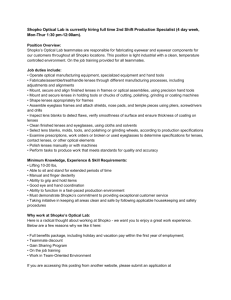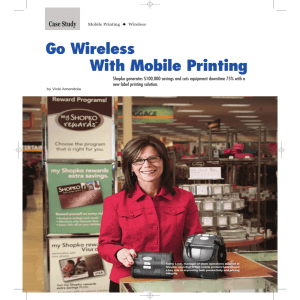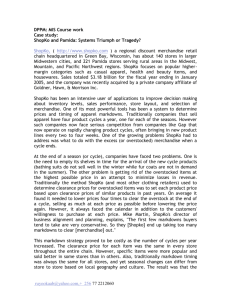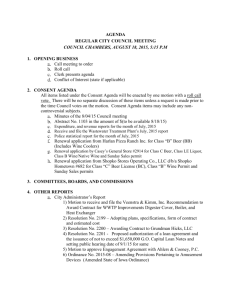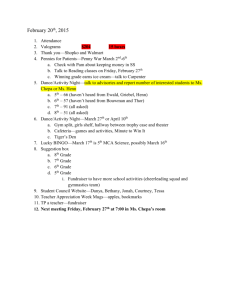Appendix VII: ShopKo Stores Inc. Case Study
advertisement
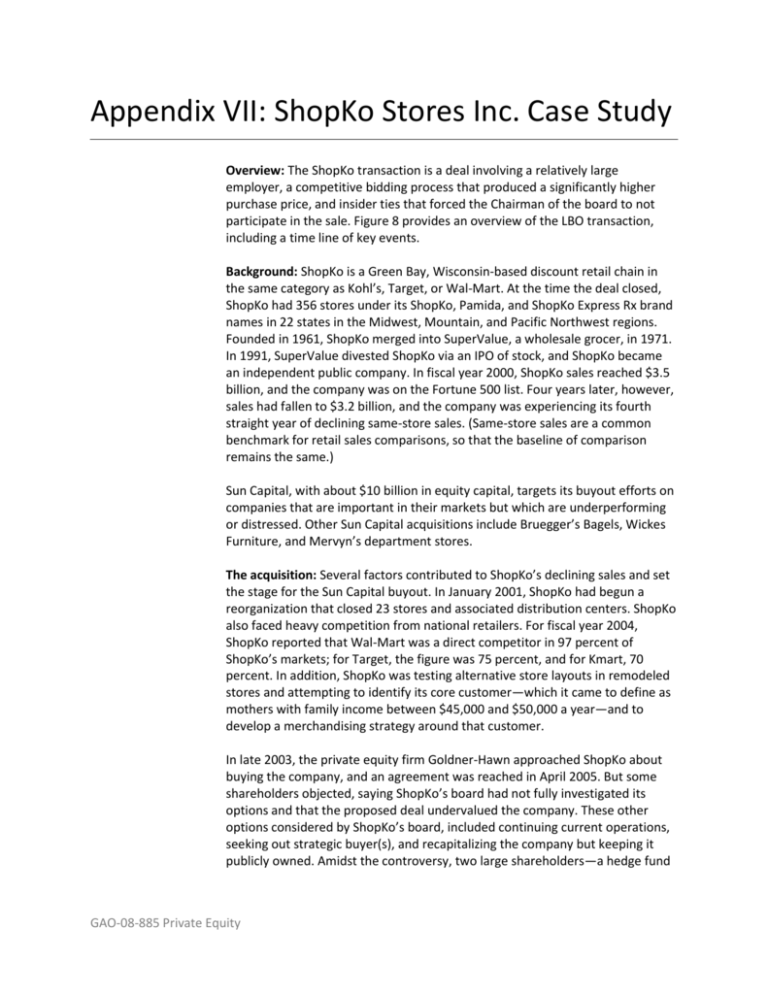
Appendix VII: ShopKo Stores Inc. Case Study Overview: The ShopKo transaction is a deal involving a relatively large employer, a competitive bidding process that produced a significantly higher purchase price, and insider ties that forced the Chairman of the board to not participate in the sale. Figure 8 provides an overview of the LBO transaction, including a time line of key events. Background: ShopKo is a Green Bay, Wisconsin-based discount retail chain in the same category as Kohl’s, Target, or Wal-Mart. At the time the deal closed, ShopKo had 356 stores under its ShopKo, Pamida, and ShopKo Express Rx brand names in 22 states in the Midwest, Mountain, and Pacific Northwest regions. Founded in 1961, ShopKo merged into SuperValue, a wholesale grocer, in 1971. In 1991, SuperValue divested ShopKo via an IPO of stock, and ShopKo became an independent public company. In fiscal year 2000, ShopKo sales reached $3.5 billion, and the company was on the Fortune 500 list. Four years later, however, sales had fallen to $3.2 billion, and the company was experiencing its fourth straight year of declining same-store sales. (Same-store sales are a common benchmark for retail sales comparisons, so that the baseline of comparison remains the same.) Sun Capital, with about $10 billion in equity capital, targets its buyout efforts on companies that are important in their markets but which are underperforming or distressed. Other Sun Capital acquisitions include Bruegger’s Bagels, Wickes Furniture, and Mervyn’s department stores. The acquisition: Several factors contributed to ShopKo’s declining sales and set the stage for the Sun Capital buyout. In January 2001, ShopKo had begun a reorganization that closed 23 stores and associated distribution centers. ShopKo also faced heavy competition from national retailers. For fiscal year 2004, ShopKo reported that Wal-Mart was a direct competitor in 97 percent of ShopKo’s markets; for Target, the figure was 75 percent, and for Kmart, 70 percent. In addition, ShopKo was testing alternative store layouts in remodeled stores and attempting to identify its core customer—which it came to define as mothers with family income between $45,000 and $50,000 a year—and to develop a merchandising strategy around that customer. In late 2003, the private equity firm Goldner-Hawn approached ShopKo about buying the company, and an agreement was reached in April 2005. But some shareholders objected, saying ShopKo’s board had not fully investigated its options and that the proposed deal undervalued the company. These other options considered by ShopKo’s board, included continuing current operations, seeking out strategic buyer(s), and recapitalizing the company but keeping it publicly owned. Amidst the controversy, two large shareholders—a hedge fund GAO-08-885 Private Equity and a real estate investment firm—individually approached Sun Capital about possible interest in participating in a ShopKo buyout. ShopKo fit Sun Capital’s focus on underperforming companies. Sun Capital also believed ShopKo had shown resilience in the face of its competition, primarily from Target and Wal-Mart. In addition, Sun Capital thought that ShopKo had strength in its pharmacy and optical business lines; that the chain had strong brand recognition and loyalty among its customers, and that it was beginning to see success in shifting its merchandise mix. However, Sun Capital executives said they were initially hesitant to participate in bidding for ShopKo because the company had already agreed to a buyout with Goldner-Hawn. In the end, Sun Capital executives said they decided to join the bidding for ShopKo because it appeared Sun Capital could pay more, for a deal it judged to be worth more, and because the Goldner-Hawn deal appeared to have what Sun Capital executives called an “insider flavor.” This was because ShopKo’s nonexecutive Chairman had talked with Goldner-Hawn about potentially becoming an investor in the private equity fund purchasing ShopKo and about post-buyout employment at ShopKo as well. (This conflict caused the Chairman, as well as another director, to recuse themselves from lengthy deliberations on sale of the company.) After the shareholder complaints raised in opposition to the Goldner-Hawn deal, Sun Capital believed the ShopKo board would welcome its offer. Sun Capital’s winning bid of $29 per share was 21 percent better than Goldner-Hawn’s initially accepted offer of $24 per share, and it boosted the deal value by $160.8 million. Strategy and implementation: Following the buyout, Sun Capital began a makeover of ShopKo operations. Sun Capital describes its approach to managing its portfolio companies as more hands-on than most private equity firms. It designates an operating partner who holds weekly calls and monthly meetings with company management. According to Sun Capital executives, these meetings help to monitor the acquired company’s health, coach its management, and identify areas for efficiencies and cost savings. ShopKo consolidated its vendors, making it a more important customer to each vendor. In addition, Sun leveraged its portfolio’s purchasing power to acquire higher quality goods at a lower cost with better credit terms, Sun Capital executives said. For example, ShopKo was able to realize what executives said were large savings in the cost of prescription drugs. The company overhauled its marketing, launching a broadcast television and radio advertising campaign that included back-to-school ads for the first time in many years. Before the buyout, ShopKo’s promotions revolved around local newspaper circulars. To capitalize on its in-store pharmacies, which executives say is a key strength, ShopKo began buying small, independent drugstores and transferring their business to ShopKo. Sun Capital executives say they plan to spend approximately $70 million annually—up from about $35 million planned for fiscal year 2005, before the takeover—to continue the remodeling of ShopKo and Pamida stores, an GAO-08-885 Private Equity initiative started before the buyout. In addition, ShopKo is opening its first new store in 6 years. These moves bring capital expenditures back up to 2004 levels. Operationally, ShopKo reorganized its five regional management offices into 14 district groups. The aim was to provide better and faster communication between store managers and field management. Sun Capital recruited a new Chief Executive Officer but retained most ShopKo management. In addition, Sun Capital decided to operate ShopKo and Pamida as separate entities. This was because Sun Capital believed the ShopKo and Pamida customer bases were sufficiently different —chiefly, with Pamida’s being more rural. Shortly after the acquisition, Sun Capital sold off ShopKo’s real estate holdings, leasing the properties back from the new owners, in an $815.3 million deal that at the time was the biggest retail sale-leaseback in U.S. history. Previously, ShopKo owned both the land and buildings at about half its stores. Sun Capital executives said the real estate deal allowed Sun Capital to retire debt used to finance the buyout and to operate ShopKo with reasonable debt ratios and ample liquidity. Using the real estate proceeds to pay down initial debt was planned at the time of the buyout, Sun Capital executives said. Results: Sun Capital executives declined to provide information on post-buyout revenue and income, but they said that revenue has been relatively level, after being on the decline before the takeover. Sun Capital executives say they believe they have put ShopKo in a better position to compete against national competitors like Target and Wal-Mart, by leveraging Sun Capital’s retailing experience and sourcing capabilities, and by allowing ShopKo to focus on improving the business away from the demands of the public marketplace. ShopKo is expanding again, and remodeling efforts are paying off, with sales at remodeled stores up 5 percent compared with a base level for stores that have not been remodeled, which executives say is a significant difference. Given pre-buyout store closings, Sun Capital judged corporate and administrative staffing to be excessive when it took control. As a result, there were a small number of layoffs in these areas after the deal closed. Overall, before the buyout, the company employed approximately 22,800—17,000 at ShopKo stores and 5,800 at Pamida stores. Today, ShopKo employs approximately 16,000. Sun Capital executives declined to provide a figure for Pamida. Overall, jobs have been lost due to store closures but are being added as new stores open. Given the geographic spread of ShopKo stores, company employment is dispersed as well, and generally, no single store is a major employer within its market area. Exit: Sun Capital plans to hold ShopKo in its portfolio for the immediate future. Eventually, according to executives, an IPO of stock is the most probable exit strategy, as there does not appear to be a strategic buyer. Sun Capital executives believe the Pamida division, which has been established as a separate internal unit, will have more exit options than the ShopKo division because of Pamida’s particular customer base. GAO-08-885 Private Equity
